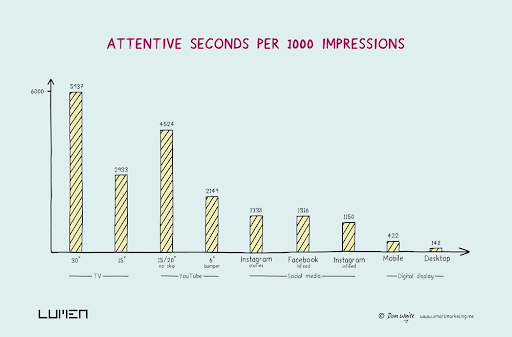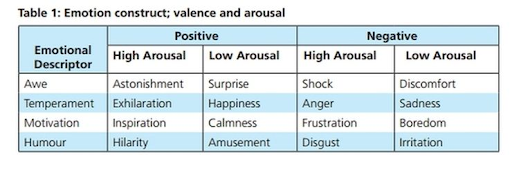10 tips for creating ads that grab the user's attention
Last year, numerous studies were conducted by various parties. Here, we would like to summarise some learnings and best practices to design a campaign that attracts and/or holds the attention.
Overall, there are 4 major factors that determine attention for a campaign.
- Quality of media
- Ad experience
- Relevance
- Creative
1. The choice of media channel is the biggest determinant of attracting attention from surfers. Internet surfers consume different media channels in different ways. For example, YouTube users are more in the mood to watch videos compared to people scrolling on their feed of social media channels. This also has its impact on the attention users pay to ads on the respective channels. Lumen has thus done some studies to determine the attentive seconds per media channel (see below).

2. Size does matter: ad size emerges in the DPG research as one of the main drivers of attention. Takeovers or full impact formats generate 4.5x as much attention as standard bannering formats. After all, these ads are viewed more and longer.
3. Higher content engagement drives more attention to ads. Surfers who scroll slower and stay on pages longer pay more attention to ads. That makes ads longer viewable so surfers are more likely to view them longer. (DPG) This is a good reason to advertise on (news) articles rather than on home pages, where people scroll and click away very quickly. According to a Teads x Lumen study, ads placed near news articles achieve 1.3x more attention than homepage ads.
4. Fewer ads per screen result in more attention
5. In the case of video ads: Forced ads take 2x as long to achieve the same effect as non-forced ads in 2s. (Teads) In other words, if people are forced to watch a video (non-skippable ads), they will watch the video with less attention than if they make the choice to watch the ad.
6. Ads that are tailored to website content (= contextual targeting) generate a higher attention span than non-targeted ads. (Forbes)
7. It is not only the size of the ad that counts, but also how much % of the banner is shown. The more of the ad is shown, the more attention there will be for the ad. For example, if half of the banner will remain below the fold, with risks that the message and/or branding clues will not come across. (Karen Nelson Field)
8. The longer the ad is on screen, the more attention will be paid to the ad. This only pays off to a certain extent - the longer the ad is shown, from a certain length of time on, will have diminishing returns. (Karen Nelson Field)
9. Unexpectedness attracts attention (Karen Nelson Field) Door onverwachts uit de hoek te komen met de boodschap en/of de creative, kan de aandacht van de surfer worden getrokken. Dit is grotendeels bepaald door emoties die worden opgewekt door de advertentie. Als deze emoties “high arousal” emoties zijn, zoals beschreven in de afbeelding hieronder, is de kans op aandacht van de gebruiker hoger dan bij low “arousal” emoties.

Note, however, that the influence emotion has on attention is a lot lower than platform choice. More specifically, half lower.
10. Attention can vary tremendously from creative to creative. For example, we know that the creative is responsible for 49% of the potential impact of a campaign (Google). Therefore, it pays to optimize the creative as much as possible toward attracting attention. Even small optimizations can pay off:
- Captions in a video
- Adding animations to a banner
- Making banners interactive
- ...
Conclusion
In this regard, attention seems to be the holy grail for a successful awareness campaign. Of course, this should be taken with a grain of salt. After all, not all attention-oriented ads lead to a sale. For one thing, much depends on the user's purchase intent. But above all, many ads fail to establish a link with the brand. Attention to an ad or brand recall is not the same thing. Proper use of branding assets such as logos and colors is crucial for this.



